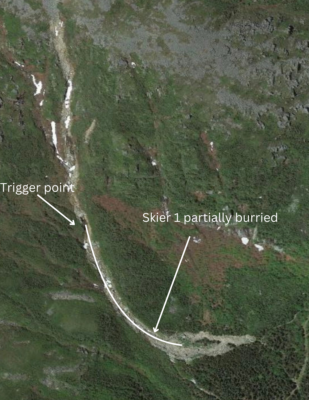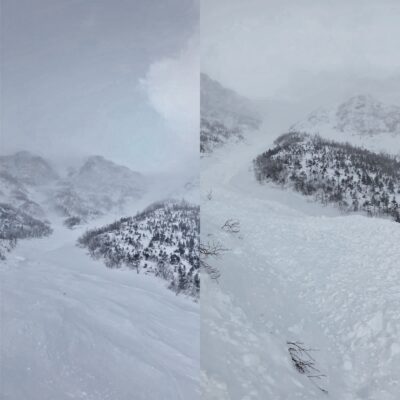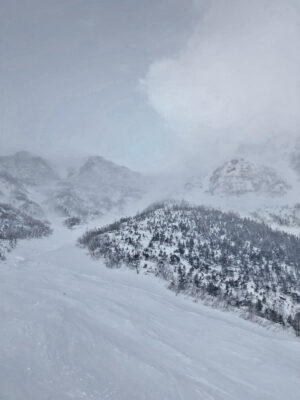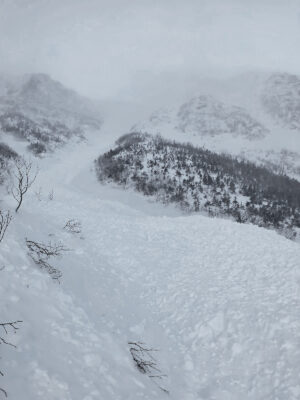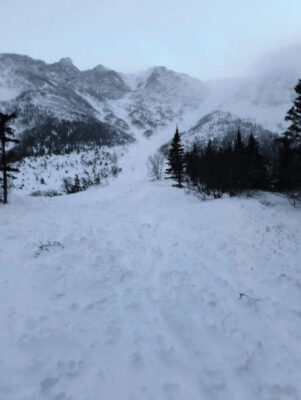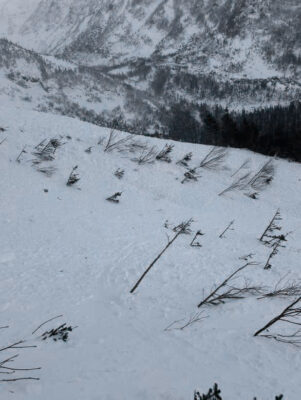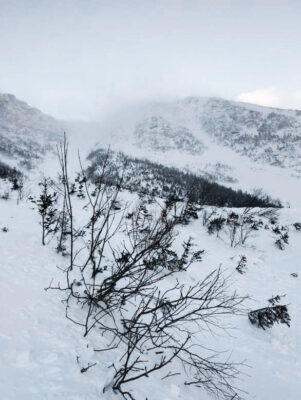Overview
At approximately 4:45 PM on Wednesday, February 26th, 2025, a solo skier (Skier 1) descending Hillman’s Highway in Tuckerman Ravine triggered an avalanche and was caught, carried, and partially buried. A second skier (Skier 2) was also in Hillman’s Highway, avoided the avalanche, and then dug Skier 1 out of the snow within minutes of the avalanche. Both skiers recognized that Skier 1 had a broken leg and would be unable to self-extricate. At this time, Skier 2 descended with the plan to look for help at Hermit Lake. Unbeknownst to them, at this same time the Harvard Cabin Caretaker, Hermit Lake Caretaker, and two bystanders were heading towards Hillman’s Highway as they had witnessed the avalanche from the deck of the AMC Hermit Lake Cabin. Three USFS Snow Rangers were notified, returned to the mountain, and with the help of Skier 2, both caretakers, and two bystanders, were quickly able to assess and splint the broken leg, and load Skier 1 into a litter for transport.
Weather/Snowpack:
The avalanche hazard rating for Wednesday, February 26 was CONSIDERABLE with a wind slab avalanche problem. Wind slabs were possible up to size D2 (large avalanches that could bury, injure, or kill a person) on northeast, east, southeast, and south aspects. The avalanche forecast “Bottom Line” read:
You could trigger a large avalanche in wind-drifted snow on steep east, and south-facing slopes above 3000 feet today. To reduce your risk, steer clear of slopes with obvious drifts and where the wind has stiffened and smoothed the snow surface. Limit your time underneath steep, connected snow slopes to reduce your exposure to natural avalanches.
In the previous 24 hours, a low pressure system out of the west moved slower than forecast which increased snow total overnight to 3.7 inches which elevated the avalanche hazard on the 26th. The snow initially fell with little to no wind and winds shifted to the northwest and quickly increased to 50-70 mph. This setup was something forecasters discussed on the morning call and wrote about in the forecast discussion:
Look out for strong-over-weak structure in new wind slabs. This snow initially fell with light winds on a firm old snow surface, this soft cohesionless snow is the weak layer of concern. As wind speeds increased, winds began to transport this light snow and build wind slabs, these slabs are the stronger layer on top. You can identify this structure by digging down to the old snow surface. The depth will help you to understand the size and using informal tests like hand shears or formal column tests will help you to understand the sensitivity.
Natural avalanches are a possibility today, especially if snow is still actively loading. The biggest red flag to look for is blowing snow onto loaded snow slopes. If you encounter this, consider limiting time under well developed snow slopes as paths in most east-facing terrain are large and fully developed.
Continued snow showers throughout the day added 1.7 inches of snow exceeding the trace to 1 inch of snow forecast. The additional snowfall increased the size of the building wind slabs, and the continued active loading prolonged their reactivity.
This reactivity during the day was noted by multiple field observations. Two professional observations (obs 1, obs 2) found shooting cracks, strong-over-weak structure, and were able to intentionally trigger small avalanches (D1) on representative test slopes. A party of two unintentionally triggered a large (D2) avalanche in Huntington Ravine and you can read more about that here.
Events
At approximately 1:30 PM, Skier 1 arrived at Pinkham Notch with plans to ski the Sherbourne Ski Trail and maybe part of Hillman’s Highway, if conditions allowed. Given the sunny weather in the valley, Skier 1 thought that the warmth and sun would have settled the snowpack and expected to find stability. Skier 1 had a beacon, probe, and shovel, and the skill to use them. Skier 1 assessed conditions along the Tuckerman Ravine Trail and noticed soft snow conditions and warm temperatures. Arriving at Hermit Lake at approximately 3:00 PM, Skier 1 noted wind above treeline and signs of active wind loading.
At this point, Skier 1 decided to ascend higher with the plan to go to the bottom of Hillman’s Highway where they used hand sheers and their ski pole to assess the snowpack and noted small isolated drifts with soft-over-hard structure. The depths of the drifts were less than boot-top. Skier 1 decided to ascend to the top of the Christmas Tree, a well known feature in Hillman’s Highway.
At the top of the Christmas Tree, Skier 1 transitioned to ski down the center of the gully and noticed a soft wind slab just below their transition point. On their third turn, they felt a collapse and noticed snow moving around them and looked uphill initially thinking it was sluff from the previous turns. This was at approximately 4:45 PM. They turned left to try to get out of the sluff’s way, they were knocked off balance by a second wave of snow, but remained upright and tried to use a backstroke motion to stay balanced. At this time they were hit by what seemed like a third wave with significantly more snow. At this point, Skier 1 was immersed and cycling between being under and on top of the snow. As the snow began to slow, Skier 1 fought to the surface, but this was challenging as the snow was hardening around them.
As the snow came to rest, Skier 1 was able to move their right arm and could clear their initially obstructed airway. Initially, they thought they were fully buried and in darkness, but by clearing their airway and creating a larger air pocket near their face, they could make out parts of the sky.
Rescue Summary
At around 4:00 PM Harvard Cabin and Hermit Lake caretakers observed a solo skier climbing Hillman’s Highway and decided to continue watching since they were concerned about the avalanche conditions and wind loading. At 4:45 PM they saw the skier descend, the avalanche, followed by the skier disappearing from view. At this point, not knowing if the skier was buried or on top of the snow, the caretakers called USFS Snow Rangers who had only recently departed the mountain for the day.
At this same time, another solo skier, Skier 2, was in Hillman’s Highway. When Skier 1 triggered the avalanche, Skier 2 was able to avoid the avalanche and when snow came to rest was quickly able to ski down to Skier 1 and dig them out within minutes. At this point, Skier 2 noticed that Skier 1 had a broken leg and would not be able to self extricate. Both skiers had concerns about a second avalanche, Skier 2 left to try to get additional help while Skier 1 crawled to attempt to exit the avalanche path.
Help was already on the way as the Harvard Cabin and Hermit Lake caretakers and two bystanders were following the trail towards the avalanche path. They found Skier 1 crawling on the snow and quickly worked to use a snowboard to slide Skier 1 down the trail.
Skier 2 had skied out of Hillman’s and was heading towards Hermit Lake to look for help. Passing the turn back uphill for the trail they heard voices and decided to head back towards Hillman’s Highway and worked to help the hasty team that was currently extricating Skier 1.
At this time, one of the USFS Snow Rangers had arrived on a snowmobile and had gathered a litter, lower leg splint, chemical heated blanket, and hypothermia wrap to package Skier 1.
At 5:45 PM, two other Snow Rangers arrived with the snow cat. When Skier 1 was fully packaged in the litter, they were loaded into the snow cat which quickly headed downhill to meet Gorham EMS.
Avalanche Statistics
Type: Soft Slab
Trigger: Skier, unintentional
Aspect: Northeast
Slope Angle: 38 degrees
Size: R3, D2
Elevation: 4600 Feet
Sliding Surface: New/Old Interface
Vertical Fall: 625 Feet
Width: ~50 Feet
Discussion
One of the main reasons we share details about avalanche incidents is for education and awareness for the greater backcountry community with the hopes of becoming collectively safer. In return for sharing this information, we ask that you take the time to read and reflect on lessons learned in a non-judgmental and constructive manner. The more you relate to all of the skiers involved the more you will be able to take away from this day. We are so glad that this event was not a fatality and that all skiers involved have the opportunity to learn for future objectives in the mountains.
All avalanche activity from February 26th highlights the high degree of spatial variability known to the Presidential Range. These subtleties have caught experienced backcountry travelers as well as professionals off-guard. While weather in the valley can be warm and spring-like, weather just up the road in the mountains can be wintry.
All skiers were familiar with the Presidential Range and the areas they were recreating in. All are regular readers of the Mount Washington Avalanche Center’s daily avalanche forecast. Skier 1 was unsure if they had read the forecast on February 26th, but was aware of the posted avalanche hazard at Hermit Lake.
In talking with Skier 1, it is now apparent to them that they missed some obvious red flags. Skier 1 noticed soft snow and active wind transport, but being in a hurry to ski after work they may have rushed which impaired their decision making. Being influenced by weather conditions at lower elevations can also be deceiving and in this case, was not accurate to the weather higher in the mountains.
Skier 1 was unsure if they would have been able to self-extricate from the snow and described feeling helpless and buried. They were unaware that Skier 2 was also in Hillman’s Highway.
The decision to ski solo decreased the skier’s margin for error even further by not having a partner that could extract them in case of a full burial, provide care in case of injury, or act as another voice in the decision making process. At face value, skiing solo should not be considered a mistake, but rather a choice that can compound the consequences of an accident in the scenario of an avalanche or injury.
As it happened, another solo skier ended up digging Skier 1 out of the snow. This ended with a very positive outcome and many lessons learned. All skiers had avalanche rescue gear, which was critical in digging Skier 1 out. In the event that Skier 2 was not there, a beacon signal could have been used by the caretakers to know that the skier was still in the avalanche path, as it is not uncommon for some skiers to ski away after triggering an avalanche and not letting anyone know. With the potential for a secondary avalanche, hangfire, and limited visibility from continued loading, it can be difficult to justify exposing rescuers to hazards when there is no confirmed victim to assist , especially if a skier did not have a searchable transceiver signal. Luckily Skier 2 noticed an arm out of the snow, and while they did not need a beacon, we are glad that all involved had them.
MWAC would like to thank all the skiers involved in this day for their openness and honesty with the hope of public awareness and education. We wish Skier 1 a speedy recovery and look forward to when they will be back out on skis.

